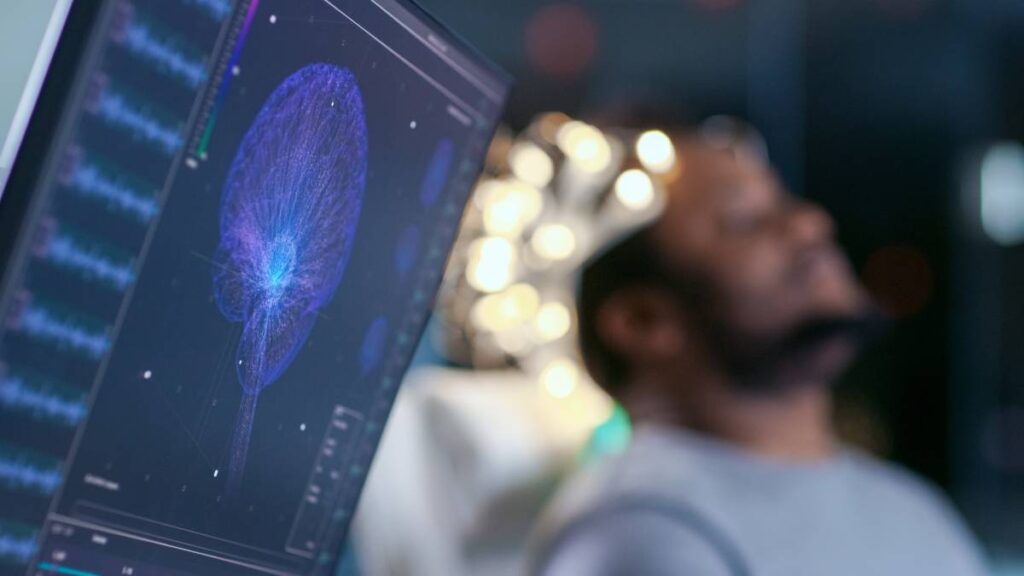Intraoperative monitoring of body organs typically focuses on either the diseased organ or overall physical functioning; the brain is not typically monitored separately [1]. However, there has been growing interest in neural monitoring as another way to assess patient status during surgery. The existing literature on neural monitoring during surgery is typically separated by the type of surgery or the organ/organ system of interest.
Central nervous system malformations are more frequent in children with congenital heart disease, particularly in patients with chromosomal defects or hypoplastic left heart syndrome (HLHS). HLHS is a birth defect where the left side of the heart develops abnormally and therefore cannot supply oxygen to the brain, so neural dysgenesis can occur in up to 30% of patients [1]. Pre-existing developmental issues in the brain such as these lead to a much higher occurrence of brain injury in heart surgery for children and neonates than adults. At-risk patient groups may benefit from neural monitoring during surgery to allow for rapid response if a complication occurs and is detected.
Electroencephalogram (EEG) recording is a useful took for neural monitoring both during surgery and outside of the surgical context. For example, it is used duringcongenital heart surgery, typically with 2-16 channels. In addition to monitoring for any neural disturbances in the perioperative space, the EEG can provide a guide for anesthetic depth and determine the criteria for electrocerebral silence, or brain death. However, the major disadvantage to using EEG is the need for a dedicated technician to place the electrodes and interpret the final result, which is neither practical nor cost-effective in busy hospital settings [1].
Transcranial Doppler ultrasound (TCD) is a sensitive, real-time monitor of cerebral blood flow and can select a precise sample without contamination from other sources. Its recordings are easy to interpret, but this device measures cerebral blood flow velocity as a proxy for blood flow, creating problems of internal validity. Therefore, simultaneous neural monitoring with multiple modalities may be needed to capture the information relevant to a particular surgery context [1].
The International Neural Monitoring Study Group (INMSG) is a multidisciplinary international group established in 2006, formed by otolaryngologists, general surgeons, laryngologists, voice and laryngeal electromyography specialists, and anesthesiologists with extensive experience. In the context of thyroid and parathyroid surgery, the INMSG recognizes that neural monitoring in the perioperative setting offers a new dimension to protecting nerves near the surgical site, as nerves appearing intact to a physician’s eye are not always functionally intact. The recurrent laryngeal nerve (RLN) and superior laryngeal nerve (SLN) may be injured during surgery; monitoring these nerves can identify when an injury has occurred and potentially identify the mechanism and site of injury [2]. A 2016 prospective clinical study examined 281 cases of injured nerves associated with postoperative complications and found the most common causes of injury to be traction, thermal, compression, clamping, suction-related injury, and transection [3]. Current applications for neural monitoring include improved rate of identification of SLN, improved preservation of SLN, neural electrical mapping of RLN which facilitates visualization, and RLN paralysis outcome improvement. In recent years, intraoperative neural monitoring is used in ~80% of thyroid surgeries performed by head and neck surgeons and over 65% of such surgeries performed by general surgeons. This number has increased significantly over the last 5 years and is predicted to continue to rise [2].
Multimodal neural monitoring, including transcranial electric motor-evoked potentials (tceMEPs), somatosensory-evoked potentials (SEPs), and electromyography, has been developed and implemented in spinal corrective surgery to discover motor function deficits. A retrospective review published in 2012 identified 176 patients who had received treatment for spinal deformity at Peking Union Medical College Hospital [4]. 5 patients awoke with neurological deficits; all 5 were detected with MEP monitoring. A steady deterioration of MEP and SEP signals notified surgeons to release pressure on the pedicle screw. Although MEP monitoring is more sensitive, SEP monitoring complements the former by being sensitive to injuries around the posterior sensory columns. When used together, it can provide continuous monitoring without procedure cessation. Additionally, post-operative neural monitoring was concluded to be useful in detecting late-onset neurological abnormalities [4,5].
The value of intraoperative neural monitoring differs depending on the type of surgery being performed; nonetheless, neural monitoring has proven to be an invaluable asset in the clinical sphere. A steady stream of empirical evidence suggests neural monitoring provides visibility, aids identification of injury, and maintains safety when operating procedures must be amended.
References
- Andropoulos, D. B., Stayer, S. A., Diaz, L. K., & Ramamoorthy, C. (2004). Neurological monitoring for congenital heart surgery. Anesthesia & Analgesia, 99(5), 1365. https://doi.org/10.1213/01.ANE.0000134808.52676.4D
- Schneider, R., Randolph, G. W., Dionigi, G., Wu, C.-W., Barczynski, M., Chiang, F.-Y., Al-Quaryshi, Z., Angelos, P., Brauckhoff, K., Cernea, C. R., Chaplin, J., Cheetham, J., Davies, L., Goretzki, P. E., Hartl, D., Kamani, D., Kandil, E., Kyriazidis, N., Liddy, W., … Dralle, H. (2018). International neural monitoring study group guideline 2018 part I: Staging bilateral thyroid surgery with monitoring loss of signal: INMSG LOS Part 1. The Laryngoscope, 128, S1–S17. https://doi.org/10.1002/lary.27359
- Dionigi, G., Wu, C.-W., Kim, H. Y., Rausei, S., Boni, L., & Chiang, F.-Y. (2016). Severity of recurrent laryngeal nerve injuries in thyroid surgery. World Journal of Surgery, 40(6), 1373–1381. https://doi.org/10.1007/s00268-016-3415-3
- Feng, B., Qiu, G., Shen, J., Zhang, J., Tian, Y., Li, S., Zhao, H., & Zhao, Y. (2012). Impact of multimodal intraoperative monitoring during surgery for spine deformity and potential risk factors for neurological monitoring changes. Clinical Spine Surgery, 25(4), E108. https://doi.org/10.1097/BSD.0b013e31824d2a2f
- Horiuchi, T., Kawaguchi, M., Inoue, S., Hayashi, H., Abe, R., Tabayashi, N., Taniguchi, S., & Furuya, H. (2011). Assessment of intraoperative motor evoked potentials for predicting postoperative paraplegia in thoracic and thoracoabdominal aortic aneurysm repair. Journal of Anesthesia, 25(1), 18–28. https://doi.org/10.1007/s00540-010-1044-9

